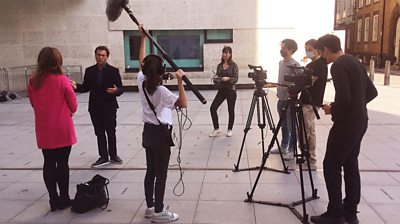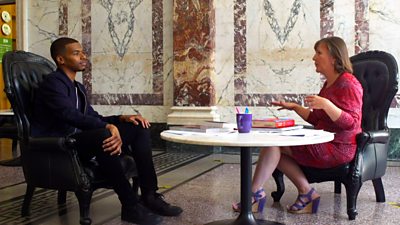
The 50:50 team is working with several , both in the UK and overseas, to help them implement 50:50 monitoring in their own content. We’re doing this to prepare and inspire the next generation of newsroom leaders to take the 50:50 methodology with them into their first jobs.
Given the impact Covid-19 is having on the graduate jobs market it feels like now, more than ever, we need to be supporting future content-makers to continue to seek out diverse voices.
So, at the end of the summer we set one of our partner universities a different kind of challenge – could they come up with video content that would tell the story of 50:50 so far and where we take it next?
We worked with a group of highly talented Film BA students from the University of Westminster who created three short videos about 50:50. Juggling a crew whilst balancing an unusual start to a new term threw up a few surprises. We asked Olivia Otts (Producer) and Miquel Sierra Altarriba (Director) to tell us a bit more about their process.
Q&A: What was it like to create a video series from scratch for a ±«Óătv team?
Olivia says: “I would say it was challenging but rewarding at the same time. I planned our shooting schedule tightly out of necessity! In terms of the biggest practical challenges - the day involved transporting equipment back and forth between four main locations in central London to fit around the tight schedules of interviewees involved.”
Olivia adds: “Ensuring that we captured the necessary interviews, voiceovers, and B-roll on time during a global flu pandemic added an extra layer of complexity. Obtaining location access and security permissions was the initial hurdle. Ensuring that COVID-19 guidelines were actually followed on-set was the true challenge on the day! I’m proud of my team for the way they adapted without compromising the final product especially Ingrid Ho, who adapted to using a boom mic to capture audio safely.”
Miquel says: “As the director, my biggest challenge was getting enough coverage and material to fill three videos that averaged around three minutes each in just one day of filming. One of the main goals was to achieve a visually stimulating style. Isabel, the production designer, played a big part in finding the best street art locations and clothing style to attract younger audiences on social media. Working closely with Miguel Cidad, the director of photography, we ensured our camera positions made the most out of the exterior spaces that we had [access to].”
Miquel adds: “Angelica Bizzotto and Ben Rolph, our camera operators, worked hard on setting up the cameras in a way that allowed contributors to stay two metres apart from each other without compromising the quality or making conversations feel distant.”
How did you complete the edit and post-production process?
Olivia says: “We originally intended to tackle the post-production process using Avid in our university’s editing suite but weren’t able to access the university campus due to increased Covid-19 restrictions. So, we quickly updated our strategy to fit a more remote workflow, using Premiere Pro on a laptop.”
Miquel says: “Post-production was both challenging and exciting. Tuana Yalcinkaya and I went through all the rushes and thought of the best way to piece them together. She learned Adobe Premiere from scratch and is now an expert in it! We adjusted multiple cuts according to the feedback we received from the other team members and the 50:50 team then made sure the final product met ±«Óătv standards and the needs of the 50:50 Project while also following our own instinct and vision for the videos.”
Olivia adds: “A challenge for me as producer was that I needed to ensure our edit would meet ±«Óătv editorial standards. For instance, how our statistics and contributors were referenced in the final cuts. Getting access to external footage provided by both the ±«Óătv and ABC Australia allowed us to bridge the gap between the footage we could safely record, and the interiors we needed to give the interviews a sense of space. When we ran into challenges with the audio levels – we were helped by one of our lecturers, Aidan McCarthy.
And finally, on reflection, is there anything the crew would do differently?
Miquel says: “During pre-production, writer, Mariia Brega and I worked to ensure the videos were engaging and social media-ready but due to Covid-19 restrictions and only having one day of filming, we had to find new ways to adjust our script within those limitations. Having considered those earlier on would have helped our creative process.”
Olivia reflects: “Looking back, we would have benefitted from ensuring that we had contributors booked in for both remote and in-person interviews further ahead of time, to avoid any last-minute scrambling to schedule people in. This would have improved the ease of shooting on the day - we would have been able to request locations for exact times with enough leeway to adjust based on what was best for the camera crew’s setup. Having more of a buffer between the shoots would have enabled us to get additional footage that may have been beneficial in the edit.”
Olivia adds: “I would have also ensured that the voiceover portions were revised and locked before shooting to avoid too many re-records. Learning from these experiences, we now have a better understanding of the value of extremely thorough pre-planning and generous timing!”
Miquel adds: “Dropping one of the interviews on the filming day would have given us more time to focus on finding the best way to position the contributors on location and to work with them on ensuring their speech was clear and engaging. Nevertheless, this project has been an exciting learning experience and I couldn't be more grateful to our team, who've worked so hard every step along the way.”
University of Westminster Crew: Producer, Olivia Otts; Director, Miquel Sierra Altarriba; Writer, Mariia Brega; Director of Photography, Miguel Cidad Piñero; Camera Operator, Angelica Bizzotto; Graphics, Ben Rolph; Editor, Tuana Yalcinkaya; Sound Recordist/Editor, Ingrid Ho; Production Design, Isabel Mejia.

-
 Find out how our partners are diversifying voices globally
Find out how our partners are diversifying voices globally -

Our partners
Discover more about our 50:50 Global Partner Network -

Previous Reports
The latest challenge results are out showing that data can effect change -

How it works
50:50's three core principles explained and how we tailor them
